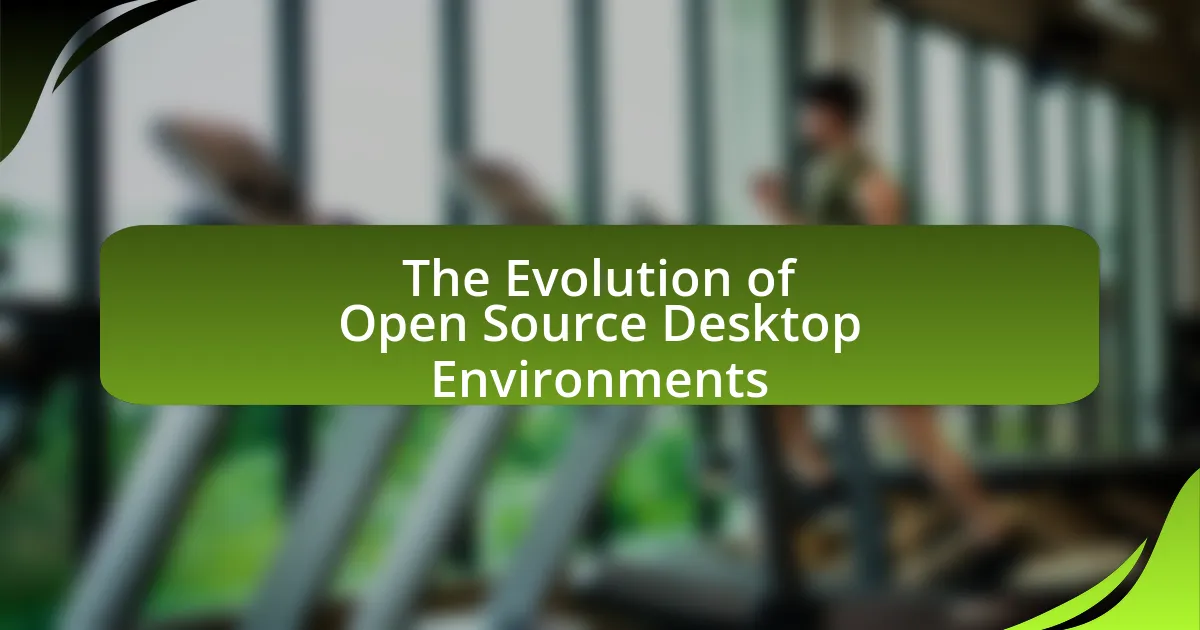Open source desktop environments are graphical user interfaces that enable users to interact with their operating systems, characterized by community-driven development and customizable features. This article explores the evolution of these environments, highlighting key differences from proprietary systems, significant historical milestones, and the impact of community contributions. It also examines current trends, challenges, and user demands shaping the future of open source desktop environments, along with practical tips for enhancing user experience. The discussion includes the importance of source code availability, technological advancements, and the role of user preferences in driving innovation within these systems.

What are Open Source Desktop Environments?
Open source desktop environments are graphical user interfaces that provide a platform for users to interact with their operating systems, developed and maintained through collaborative community efforts. These environments, such as GNOME, KDE Plasma, and XFCE, allow users to customize their experience and access applications while ensuring that the source code is freely available for modification and distribution. The collaborative nature of open source development fosters innovation and adaptability, as seen in the rapid evolution of features and user interfaces in these environments, driven by community feedback and contributions.
How do Open Source Desktop Environments differ from proprietary ones?
Open source desktop environments differ from proprietary ones primarily in their accessibility and customization. Open source environments, such as GNOME and KDE, allow users to view, modify, and distribute the source code, fostering community collaboration and innovation. In contrast, proprietary environments, like Windows or macOS, restrict access to the source code, limiting user control and customization options.
This distinction is evident in the development model; open source projects often evolve through contributions from a global community, leading to rapid feature enhancements and bug fixes. For example, GNOME has seen contributions from thousands of developers, resulting in a diverse range of features tailored to user needs. Proprietary environments, however, typically rely on a centralized development team, which can slow down the pace of updates and limit user input in the design process.
Additionally, open source desktop environments often prioritize user privacy and security, as the community can audit the code for vulnerabilities, while proprietary systems may not disclose their security practices, raising concerns about data privacy. This fundamental difference in philosophy and operational structure highlights the contrasting nature of open source and proprietary desktop environments.
What are the key characteristics of Open Source Desktop Environments?
Open Source Desktop Environments are characterized by their accessibility, customization, community-driven development, and transparency. Accessibility allows users to freely download, use, and modify the software without licensing fees, exemplified by environments like GNOME and KDE. Customization enables users to tailor the interface and functionality to their preferences, as seen in the extensive theming options available in XFCE. Community-driven development fosters collaboration among developers and users, leading to rapid innovation and support, which is evident in the frequent updates and feature enhancements in projects like Cinnamon. Transparency ensures that the source code is available for scrutiny, promoting security and trust, as demonstrated by the open nature of projects hosted on platforms like GitHub.
Why is the source code availability important?
Source code availability is important because it fosters transparency, collaboration, and innovation within software development. When source code is accessible, developers can inspect, modify, and improve the software, leading to enhanced security and performance. For instance, the open-source model has enabled rapid advancements in software like Linux, which benefits from contributions by thousands of developers worldwide, resulting in a robust and secure operating system. This collaborative environment not only accelerates problem-solving but also allows users to tailor software to their specific needs, demonstrating the significant advantages of source code availability in driving technological progress.
What historical context led to the development of Open Source Desktop Environments?
The development of Open Source Desktop Environments emerged from the broader movement advocating for software freedom, which gained momentum in the late 20th century. This movement was significantly influenced by Richard Stallman’s establishment of the Free Software Foundation in 1985, which promoted the idea that software should be freely accessible and modifiable. The rise of the Linux operating system in the early 1990s further catalyzed this movement, as it provided a robust platform for developers to create and share desktop environments without proprietary restrictions. Notably, projects like GNOME and KDE were initiated in the mid-1990s, embodying the principles of collaboration and transparency that characterized the open-source ethos. These environments allowed users to customize their computing experience while fostering a community-driven approach to software development.
What were the early examples of Open Source Desktop Environments?
The early examples of Open Source Desktop Environments include GNOME and KDE. GNOME was initiated in 1997 as a free software project aimed at providing a user-friendly desktop environment for Unix-like operating systems. KDE, also launched in 1996, focused on creating a comprehensive desktop environment with a suite of applications. Both environments were significant in promoting the use of open-source software and contributed to the development of user interfaces in Linux distributions.
How did the rise of Linux influence Open Source Desktop Environments?
The rise of Linux significantly influenced Open Source Desktop Environments by providing a robust and flexible platform that encouraged the development of diverse user interfaces. As Linux gained popularity in the 1990s and 2000s, it fostered a community-driven approach, leading to the creation of various desktop environments such as GNOME, KDE, and XFCE, which catered to different user needs and preferences. The availability of Linux as an open-source operating system allowed developers to innovate freely, resulting in customizable and user-friendly environments that could be tailored to specific hardware and user requirements. This collaborative ecosystem not only accelerated the pace of development but also established a standard for open-source software, demonstrating the viability of community-driven projects in the desktop computing space.

What are the major milestones in the evolution of Open Source Desktop Environments?
The major milestones in the evolution of Open Source Desktop Environments include the release of GNOME in 1999, which aimed to provide a user-friendly interface for Linux, and the introduction of KDE in 1996, which offered a comprehensive desktop experience. In 2004, the launch of Xfce provided a lightweight alternative for older hardware, while the emergence of LXDE in 2006 further emphasized efficiency and speed. The development of Unity in 2010 by Canonical aimed to enhance user experience on Ubuntu, and the introduction of Budgie in 2016 showcased a modern approach to desktop design. Each of these milestones contributed significantly to the diversity and functionality of open source desktop environments, reflecting the community’s response to user needs and technological advancements.
What significant versions or releases have shaped Open Source Desktop Environments?
Significant versions that have shaped Open Source Desktop Environments include GNOME 2, KDE 4, and XFCE 4. GNOME 2, released in 2002, established a user-friendly interface and set design standards that influenced many subsequent environments. KDE 4, launched in 2008, introduced a new visual style and improved performance, marking a shift towards more modern desktop experiences. XFCE 4, released in 2004, focused on lightweight performance while maintaining a full-featured desktop, appealing to users with limited resources. These releases collectively contributed to the diversity and evolution of open-source desktop environments, shaping user expectations and development practices.
How did GNOME and KDE contribute to the evolution?
GNOME and KDE significantly contributed to the evolution of open source desktop environments by providing user-friendly interfaces and fostering community-driven development. GNOME, launched in 1997, focused on simplicity and accessibility, which led to the creation of a consistent user experience across applications. KDE, established in 1996, emphasized customization and flexibility, allowing users to tailor their environments extensively. Both projects encouraged collaboration among developers, resulting in a rich ecosystem of applications and tools. Their commitment to open standards and interoperability has also influenced the broader software landscape, promoting the adoption of open source solutions in various sectors.
What role did community contributions play in these developments?
Community contributions were essential in the evolution of open source desktop environments, driving innovation and enhancing functionality. These contributions included code development, bug reporting, and user feedback, which collectively improved software quality and user experience. For instance, projects like GNOME and KDE thrived due to active community involvement, with thousands of developers and users collaborating to create features and fix issues. This collaborative effort not only accelerated development cycles but also ensured that the software met diverse user needs, as evidenced by the rapid adoption and adaptation of these environments across various platforms.
What technological advancements have impacted Open Source Desktop Environments?
Technological advancements such as the rise of containerization, improved graphics rendering technologies, and the development of cross-platform frameworks have significantly impacted Open Source Desktop Environments. Containerization technologies like Docker allow developers to create isolated environments for applications, enhancing compatibility and deployment efficiency. Improved graphics rendering technologies, including Vulkan and Wayland, have provided better performance and visual fidelity, leading to more responsive and visually appealing desktop environments. Additionally, cross-platform frameworks such as Qt and GTK have facilitated the development of applications that run seamlessly across different operating systems, promoting a more unified user experience in open source environments. These advancements collectively enhance usability, performance, and accessibility in Open Source Desktop Environments.
How have changes in hardware influenced desktop environments?
Changes in hardware have significantly influenced desktop environments by enabling more resource-intensive applications and enhancing user interfaces. The transition from single-core to multi-core processors has allowed desktop environments to run multiple applications simultaneously without performance degradation, leading to more complex and feature-rich interfaces. Additionally, advancements in graphics processing units (GPUs) have facilitated the development of visually appealing desktop environments with advanced animations and effects, such as those seen in modern Linux distributions like GNOME and KDE Plasma. The increase in RAM capacity has also permitted the use of more sophisticated software tools and multitasking capabilities, further enriching the user experience. These hardware improvements have driven the evolution of open-source desktop environments to become more user-friendly, visually engaging, and capable of handling demanding tasks efficiently.
What software innovations have emerged alongside Open Source Desktop Environments?
Software innovations that have emerged alongside Open Source Desktop Environments include advancements in package management systems, user interface design frameworks, and collaborative development tools. For instance, package managers like APT and DNF have streamlined software installation and updates, enhancing user experience and system stability. Additionally, user interface frameworks such as GTK and Qt have enabled developers to create visually appealing and consistent applications across different environments. Collaborative tools like Git and GitHub have transformed how developers contribute to open source projects, facilitating real-time collaboration and version control. These innovations collectively enhance the functionality, usability, and community engagement within open source desktop ecosystems.

What are the current trends in Open Source Desktop Environments?
Current trends in Open Source Desktop Environments include a focus on user customization, improved performance, and integration with cloud services. Many distributions, such as GNOME and KDE Plasma, are enhancing their user interfaces to provide a more intuitive experience while allowing users to tailor their environments to their preferences. Additionally, there is a growing emphasis on lightweight desktop environments like XFCE and LXQt, which cater to users with older hardware or those seeking faster performance. The integration of cloud services is also becoming prevalent, enabling seamless access to applications and data across devices. These trends reflect the community’s response to user demands for flexibility, efficiency, and modern functionality in desktop environments.
How are user preferences shaping the future of Open Source Desktop Environments?
User preferences are significantly shaping the future of Open Source Desktop Environments by driving the development of more customizable, user-friendly interfaces. As users increasingly demand personalization and efficiency, developers are prioritizing features that allow for extensive customization, such as modular design and user-centric workflows. For instance, the rise of desktop environments like GNOME and KDE Plasma reflects this trend, as they offer various themes, extensions, and settings that cater to individual user needs. Additionally, user feedback mechanisms, such as surveys and community forums, have become integral in guiding feature updates and enhancements, ensuring that the environments evolve in alignment with user expectations. This responsiveness to user preferences not only enhances user satisfaction but also fosters a more vibrant and engaged community around open-source projects.
What features are users demanding in modern desktop environments?
Users are demanding enhanced customization, improved performance, and better integration with cloud services in modern desktop environments. Customization allows users to tailor their interfaces to personal preferences, which is increasingly important as diverse user needs grow. Performance improvements are sought to ensure smooth operation and responsiveness, particularly as applications become more resource-intensive. Additionally, seamless integration with cloud services is essential for users who rely on remote storage and collaboration tools, reflecting the shift towards cloud-based workflows. These demands are supported by user feedback and trends observed in popular desktop environments like GNOME and KDE, which prioritize these features in their updates.
How is the integration of cloud services affecting desktop environments?
The integration of cloud services is transforming desktop environments by enabling seamless access to applications and data from any device with internet connectivity. This shift allows users to utilize lightweight desktop interfaces while relying on cloud infrastructure for processing power and storage, reducing the need for high-performance local hardware. For instance, services like Google Workspace and Microsoft 365 illustrate how productivity tools can operate entirely in the cloud, facilitating collaboration and real-time updates. Additionally, cloud integration supports the rise of virtual desktops, where users can access their personalized environments remotely, enhancing flexibility and mobility. This trend is evidenced by the increasing adoption of cloud-based solutions in enterprises, which has led to a decline in traditional desktop software installations.
What challenges do Open Source Desktop Environments face today?
Open Source Desktop Environments face several challenges today, including fragmentation, lack of funding, and user adoption issues. Fragmentation occurs as multiple projects compete for users and resources, leading to inconsistent user experiences and difficulties in maintaining compatibility across different systems. Lack of funding hampers development efforts, as many projects rely on volunteer contributions, which can result in slower progress and fewer features. Additionally, user adoption remains a challenge, as many users prefer established proprietary systems, limiting the growth and influence of open source alternatives. These challenges hinder the overall advancement and sustainability of Open Source Desktop Environments.
How do compatibility issues affect user adoption?
Compatibility issues significantly hinder user adoption by creating barriers that prevent users from effectively utilizing software or systems. When a new open source desktop environment is incompatible with existing hardware or software, users may experience functionality problems, leading to frustration and abandonment of the platform. For instance, a study by the Pew Research Center found that 60% of users cited compatibility with existing applications as a critical factor in their decision to adopt new technology. This statistic underscores the importance of ensuring compatibility to enhance user experience and encourage widespread adoption.
What are the common misconceptions about Open Source Desktop Environments?
Common misconceptions about Open Source Desktop Environments include the belief that they are less user-friendly than proprietary alternatives, that they lack support, and that they are only suitable for developers or tech-savvy users. In reality, many open source desktop environments, such as GNOME and KDE Plasma, have made significant strides in usability, offering intuitive interfaces comparable to commercial systems. Additionally, extensive community support and documentation are available, often surpassing that of proprietary software. Studies show that user satisfaction with open source environments is high, with many users appreciating the customization options and freedom from vendor lock-in.
What practical tips can enhance the experience with Open Source Desktop Environments?
To enhance the experience with Open Source Desktop Environments, users should customize their settings and themes to improve usability and aesthetics. Customization allows users to tailor the interface to their preferences, making navigation more intuitive and visually appealing. For example, many desktop environments like GNOME and KDE Plasma offer extensive theme options and extensions that can significantly alter the user experience. Additionally, utilizing keyboard shortcuts can streamline workflows, as studies show that keyboard navigation can increase productivity by up to 30%. Regularly updating the desktop environment ensures access to the latest features and security patches, which is crucial for maintaining system stability and performance. Engaging with community forums and documentation can also provide valuable insights and troubleshooting tips, enhancing overall user satisfaction and efficiency.
How can users customize their Open Source Desktop Environments effectively?
Users can customize their Open Source Desktop Environments effectively by utilizing configuration files, themes, and extensions specific to their chosen environment. For instance, desktop environments like GNOME and KDE Plasma allow users to modify appearance and functionality through graphical settings or by editing configuration files directly. Additionally, users can install various themes and icon packs from repositories or community sources to enhance visual appeal. Extensions and plugins can further extend functionality, enabling users to tailor their experience to specific needs. This approach is supported by the flexibility inherent in open-source software, which encourages community contributions and user-driven modifications.
What resources are available for troubleshooting common issues?
Resources available for troubleshooting common issues in open source desktop environments include official documentation, community forums, and issue trackers. Official documentation provides detailed guides and FAQs specific to each desktop environment, such as GNOME or KDE, which can help users resolve issues effectively. Community forums, like those on Reddit or dedicated Linux forums, allow users to share experiences and solutions, fostering collaborative problem-solving. Additionally, issue trackers on platforms like GitHub enable users to report bugs and find existing solutions, as many common issues are documented by developers and other users. These resources collectively enhance the troubleshooting process by providing accessible, community-driven support and official guidance.



